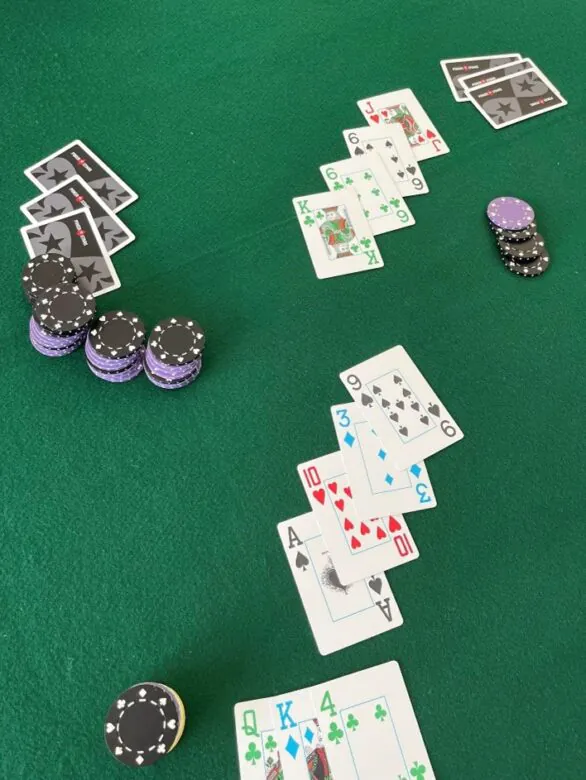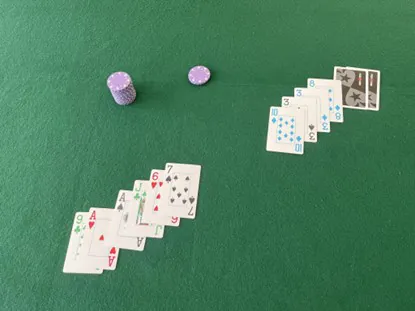Mixed Games Strategy Tips #1

-
T&Cs Apply | Play Responsibly | GambleAware
18+ | Play Responsibly | T&C Apply
-
T&Cs Apply | Play Responsibly | GambleAware
+18 / T & C apply / Play responsible

- Fact Checked by: PokerListings
- Last updated on: July 22, 2025 · 12 minutes to read
Whether to Fold in Fixed Limit Games When Getting Huge Pot Odds
When we play No Limit Texas Hold Em and Pot Limit Omaha and face a big bet on the river we have to consider a number of factors to help decide whether to fold, call or raise. Simply put, the smaller the bet in relation to the size of the pot, the more often we decide to call because it brings in a greater proportion of value hands the opponent can be betting that we can beat.
When playing fixed limit poker and facing a bet on the river, the bet is always a specific size and often the pot is very large in relation to the size of that bet. So, we should never fold, right? WRONG!! Let me give you an extreme example from a hand I observed when playing a live HORSE tournament in Spring 2023.
Seven Card Stud Hand
In this hand I had folded during the first round of betting and watched the player to my left, we’ll call him Ramon, and the player to my right, let’s say Jurgen, get into a raising war. Names have been changed to protect the potentially embarrassed. Many bets went into the pot on the early streets of play as both players represented strong hands. When Jurgen paired his 6 on fifth street and this gave him the betting lead, the action slowed down just a little. Now, Jurgen was betting and Ramon just calling.
Dear reader, if you don’t understand the term “fifth street” it refers to the point in Seven Card Stud where each player has five cards in front of them, two face down and three face up. It is a key part of a hand because this is the moment where the betting size doubles from the previous betting rounds. Read more in our rules description of Seven Card Stud. Even after the last card had been dealt to each player, Jurgen bet and Ramon called. At this point, Jurgen declared “two pairs” and Ramon said “yes, you win, I know you win” and showed down his full hand – ace high! I pointed out to Ramon that he couldn’t even beat the pair of sixes that was showing, and he said he didn’t want to fold because the pot was too big…

To be fair to Ramon, he is a normally excellent poker player and I think the amount of wine he had consumed might have played a part in him making this call!
Some Clarity About this Article
Before I go on, there are many hands where there is another option that you might consider – raising. This article is purely about the type of hand where raising makes no sense either for value or as a bluff. Where you have a pure bluff catcher and if you raise, the opponent is folding worse hands and calling or reraising hands that have you beat.
Fold or Call: The Basic Principle
In his still authoritative book, The Theory of Poker (1987), David Sklansky wrote on the subject of the decision whether to call or fold to an opponent’s bet on the last street of a hand:
“The question is: Are your chances of winning the pot better than the odds you are getting from the pot, either because your hand is better than your opponent’s or because your opponent is bluffing? If you think your chances are better, you call. If not, you fold.”
Note that in a tournament setting there is also a risk premium at play: this concept is outside the scope of this article, save to say you should call a little less often in tournaments than you do in cash games.
The decision to call or fold boils down to a purely mathematical problem. You calculate the pot odds – to call it costs x and the pot is y, the pot odds being x/(x+y). In Ramon’s case, and I am working this out from fading memory, I think he was getting about 9.5:1 in pot odds to make the call. He would need to have the best hand only just over 10% of the time to justify making the call. The problem is, in his case, he was going to have the best hand 0% of the time!
It would have been different if Ramon had started the hand with a big pair and never improved, in which case he would have to make his decision based on some estimate of the frequency with which Jurgen had been aggressive with some kind of draw that missed and he was betting the river, or seventh street, with only a pair of sixes as a bluff.
It’s Not Just the River
This next example is also from a hand of Seven Card Stud, one I recently played on PokerStars. My opponent in the hand had brought the action in with the 8 of diamonds showing and was the only person who called after I completed the betting with an ace showing. I also had an ace in the hole. For this hand, it is relevant to note that none of the other six players dealt in the hand had a diamond showing or an 8.
On fourth street I didn’t improve, and my opponent picked up the 3 of diamonds. When I continued betting, I was surprised to see my opponent reraise. I made the call and went on to fifth street to evaluate further.
A factor of note is that a couple of hands previously I had seen the same player reraise against a continuation bet on fourth street when he had JT showing, and he got to showdown. I could see that he had reraised fourth street with an open-ended straight draw, and while he kept up the aggression on every betting round, he did hit the straight but only on sixth street.
Given I knew my opponent was capable of reraising as a semi bluff, which is a strong tactic in this game, I felt his range at this point was:
- Trip 8s, trip 3s or two pairs, 83 over 3s, all hands that beat me. I had a lot of equity against two pairs but very little against three of a kind.
- Four diamonds. I was ahead of this hand right now but an equity dog.
- A big pair in the hole. With this kind of hand, I would expect him to call down and let an ace keep bluffing, but he might become aggressive with some frequency. I would be a slight favourite against this type of hand.
- A pair of 8s.
- If he had any kind of a bluff in his range, it was likely to be that he had an ace in the hole.
Given that the cards I had seen included no blockers to the first two hand types listed, and plenty of blockers to the others, I weighted his range towards the trips / two pair / flush draw combinations. Let’s see some equities for the various hand types. All equity calculations done using Pro Poker Tools Odds Oracle.
My hand: 9♣A♠\A♥J♣
Dead cards (open cards of the other players on third street): 9♥T♠J♠Q♠K♣K♥
Opponent’s hand: xx\8♦3♦
| Where xx is: | My Equity % | Opponent Equity % |
|---|---|---|
| 3♠3♥ | 12.1 | 87.9 |
| 8♣8♠ | 11.7 | 88.3 |
| 8♥3♣ | 39.8 | 60.2 |
| J♦6♦ | 38.1 | 61.9 |
| Q♣Q♦ | 56.7 | 43.3 |
| Q♦8♣ | 54.4 | 45.6 |
| A♣K♦ | 74.6 | 25.4 |
On fifth street he picked up a 3, and me a total blank. Let’s have another look at the equities now:
My hand: 9♣A♠\A♥J♣6♥
Dead cards: 9♥T♠J♠Q♠K♣K♥
Opponent’s hand: xx\8♦3♦3♠
| Where xx is: | My Equity % | Opponent Equity % |
|---|---|---|
| 3♣3♥ | 0.2 | 99.8 |
| 8♣8♠ | 2.5 | 97.5 |
| 8♥3♣ | 2.9 | 97.1 |
| J♦6♦ | 35.4 | 64.6 |
| Q♣Q♦ | 38.1 | 61.2 |
| Q♦8♣ | 35.8 | 64.2 |
| A♣K♦ | 66.6 | 33.4 |
Facing a bet, I decided to call despite my equity dropping to the floor against a portion of his range and deteriorating against other stuff. With the small bit of history I have against this player and the lack of diamonds visible anywhere else, I was heavily weighting his holding towards diamonds. I am an underdog against diamonds according to the table but what equity do I need to call his bet at this point?
Bets that had gone in so far were 2 small bets on third street, 4 small bets on 4th and one big bet on 5th, plus the antes. The antes probably added up to around a small bet. It was costing me one big bet on fifth street and the pot held (.5+1+2+1) = 4.5 big bets, plus my bet if I called: this meant I needed 1/5.5 = 18.2% equity to continue against diamonds, and as you can see, I had 35.4%.
Sixth street was horrible: the villain caught another diamond and me another blank. When he bet, I folded quickly.
Let’s look at the equities now:
My hand: 9♣A♠\A♥J♣6♥7♠
Dead cards: 9♥T♠J♠Q♠K♣K♥
Opponent’s hand: xx\8♦3♦3♠T♦
| Where xx is: | My Equity % | Opponent Equity % |
|---|---|---|
| 3♣3♥ | 0 | 100 |
| 8♣8♠ | 0 | 100 |
| 8♥3♣ | 0 | 100 |
| J♦6♦ | 0 | 100 |
| Q♣Q♦ | 22.9 | 77.1 |
| Q♦8♣ | 21.8 | 78.2 |
| A♣K♦ | 55.9 | 44.1 |
You can see that the only hands I have sufficient equity to make the call against – now needing 1/6.5 = 15.4% equity – are high pair, split 8s and the ace in the hole. These were never a big part of his range as far as I saw it, so I am more than happy with the fold.
Multi Way Hands
In multi way pots your calling range usually must be tighter by some margin. It is less likely that a player will be bluffing into a multi way pot in a fixed limit game. Not only that, but value bets will also be higher in players’ ranges because there are more opponents to beat – some hands that will be value bets heads up become showdown value that can check-call in multi way pots.
Your position is important. If you have players still to act behind you and you are facing a value bet only holding a bluff catcher you must be aware that anyone behind you might be waiting with a hand that beats you and that they will not fold.
When you are last to act after someone has bet, your decision can be affected by whether other players have called the bet or folded. If anyone else has called, they are representing strength even if the original bettor is somehow bluffing into this crowd. If everyone has folded, you must estimate the bettor’s bluffing frequency and consider how many value hands they can be betting that you can beat.
The rule is therefore that you must tighten up your calling range against multiple opponents. As with any rule, there are exceptions…
Deuce to Seven Triple Draw Lowball
This is a great poker game, played with a limit betting structure, that sometimes provides interesting multi way situations. Read our article for a full understanding of the rules and basic strategy of 2-7 Triple Draw Lowball. When someone bets into two or more players the bet tends to be for value more often than a bluff as with any other game. However, some players will expand their value range, rather than reduce it, and for good reason. Every player who stays in a hand drawing is trying to catch the same cards and is holding some of the cards the opponents want to draw. Added to that, the bettor might well have paired their low cards along the way and ended up with a lowball hand that is far enough away from the nuts that it would not be a value bet heads up, but card removal – the cards the player has seen plus all the low cards the other players have obviously held to be continuing to draw – means that it is unlikely there are enough low cards for really nutted hands to be out there. This assumes the deck has not been reshuffled with some already discarded low cards reintroduced to those available to be drawn at some point during the hand!
When facing a river bet in a multi way pot, I would still recommend having a tight range to call when there are still players to act behind. I am assuming everyone drew at least one card on the last drawing round. As always, the tendencies of your opponents will affect your decision.
If you are the last to act after a player has bet and all the other opponents have now folded, and you are holding exactly 95432, you need to think. Factors that might make you fold are:
- An overly straightforward or nitty bettor who is unlikely to find value bets further down the range than your hand.
- The deck has been reshuffled.
- The cards you have discarded along the way have all been higher than 8, meaning the card removal effect works a little more in favour of your opponent having stronger value.
Don’t come asking me for a refund if you make a call with a hand like this, it will often be behind. But as always, you need to consider the pot odds being offered and compare that to the realistic likelihood that your opponent is value betting a 9 that you beat. Or even a 10. Mostly a fold is the best option, but you are playing poker – base your decision on your best reads and instincts and remember to apply the mathematical concepts of pot odds and showdown odds to drive your decision.
Interestingly, if you feel that your opponent is capable of value betting a 9, you now have to consider raising if you have a hand that cannot win at showdown… but that’s for another article!
Conclusion
In these situations where the pot odds you are being offered are compelling, but your opponent is representing strength and all you have is a bluff catcher, the smart play is often to fold. Before doing so you need to consider all the factors at play, and we have seen the main considerations are:
- Hand reading.
- Number of players in the hand.
- Pot odds versus showdown value.
- Understanding the game you are playing.
- Opponent tendencies.
When you make a good fold the money you save is money you can use to buy something when the game is over. The problem you face is, the money in the pot would enable you to buy so much more! Nevertheless, if you are playing fixed limit games and can make good decisions to fold in these games with the correct frequency, this will have a very positive long-term effect on your poker results.
The decisions can be difficult and the feeling of satisfaction when you get these decisions right is immense. This is real money poker.
-
- 100% up to $2000
T&Cs Apply | Play Responsibly | GambleAware
18+ | Play Responsibly | T&C Apply
-
CoinPoker4.1
- 33% Weekly
- 150% up to 2000$
T&Cs Apply | Play Responsibly | GambleAware
+18 / T & C apply / Play responsible
-
Stake.US Poker4.3
- Rakeback 5%
- $55 Stake Cash + 260K Gold Coins
T&Cs Apply | Play Responsibly | GambleAware
18+ | Play Responsibly | T&C Apply
-
- 100% up to $1000
T&Cs Apply | Play Responsibly | GambleAware
T&Cs Apply | Play Responsibly | GambleAware
-
T&Cs Apply | Play Responsibly | GambleAware
18+ | T&Cs Apply | Play Responsibly | GambleAware




